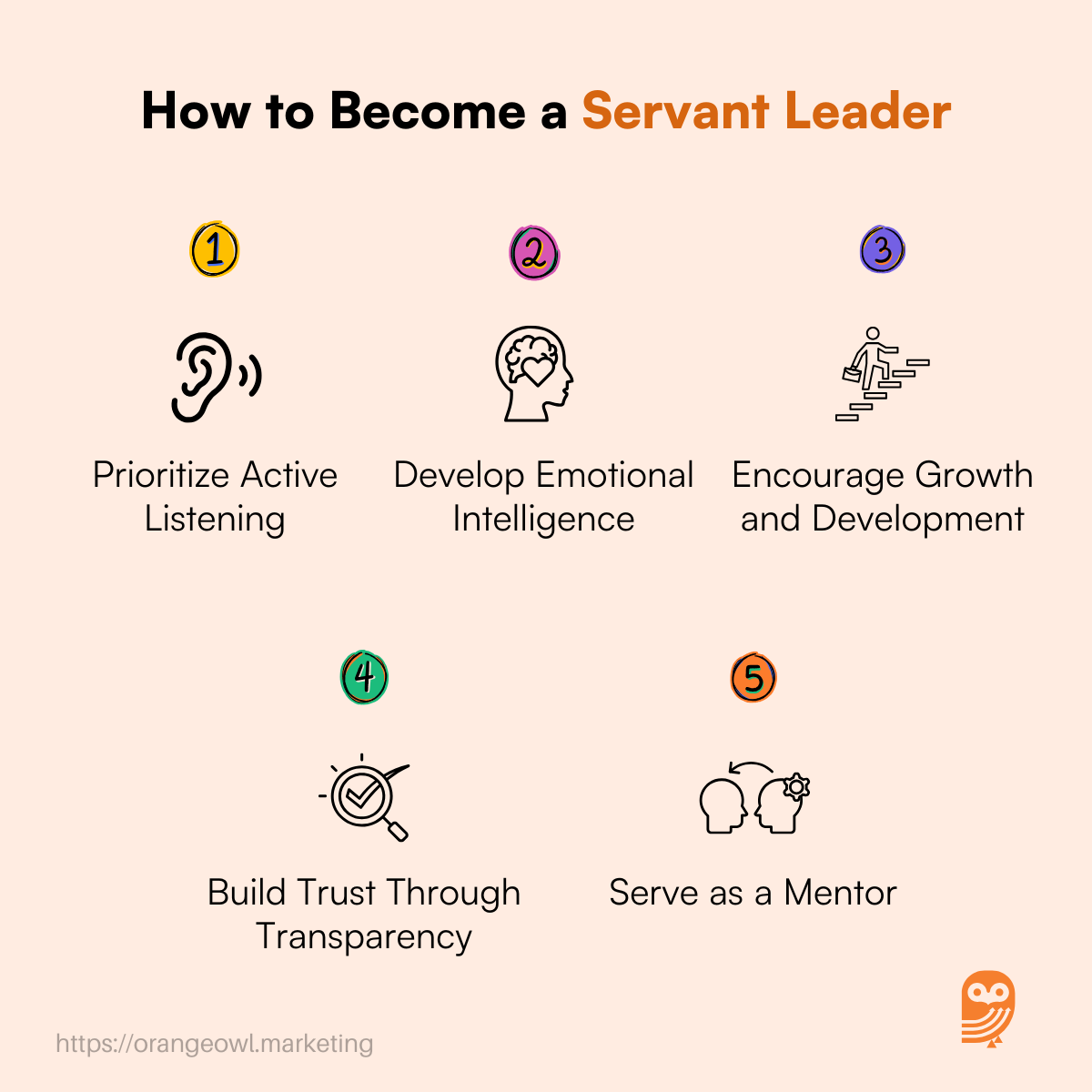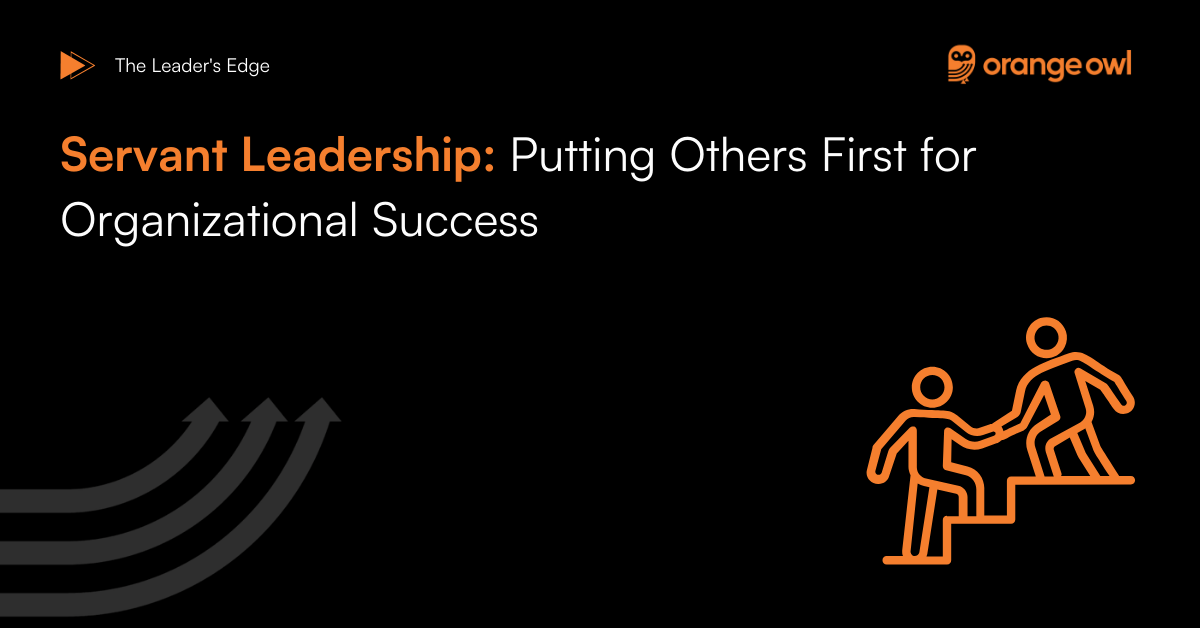What is Servant Leadership?
Servant leadership, a concept popularized by Robert Greenleaf in the 1970s, focuses on serving others as the primary objective of leadership. A servant leader prioritizes the needs of their team, empowers individuals to reach their full potential, and fosters a culture of trust, collaboration, and shared purpose.
Core Principles of Servant Leadership:
Empathy: Actively listening to and understanding team members’ perspectives.
Stewardship: Taking responsibility for the well-being of the team and organization.
Commitment to Growth: Supporting personal and professional development for employees.
Community Building: Creating a sense of belonging and mutual support within the organization.
Foresight: Anticipating future opportunities and challenges to guide the team effectively.
What Servant Leadership Is Not
While servant leadership is about putting others first, it doesn’t mean neglecting organizational goals or ceding authority. Here’s what it is not:
Being a People-Pleaser: Servant leaders balance the needs of individuals with the organization’s objectives.
Avoiding Tough Decisions: They address challenges head-on, guided by what’s best for the team and organization.
Micromanaging: Servant leaders trust their teams and delegate effectively, allowing autonomy while providing support.
Benefits of Servant Leadership
1. Improved Employee Motivation
Servant leaders foster a sense of purpose, boosting employee engagement.
Example: Google’s servant leadership practices, such as its 20% time initiative, allow employees to work on passion projects, driving innovation and motivation.
2. Increased Employee Satisfaction
When employees feel valued, they are more likely to stay committed to the organization.
Example: Zappos’ servant leadership culture emphasizes employee happiness, resulting in high retention rates.

3. Enhanced Performance and Collaboration
Servant leaders create environments where teams thrive and collaborate effectively.
Example: The transformation at Ford under Alan Mulally’s servant leadership highlights how a collaborative, supportive approach can revitalize performance.
4. Stronger Organizational Reputation
Organizations known for servant leadership attract top talent and loyal customers.
Example: Companies like HubSpot and LinkedIn are recognized for their servant leadership cultures, boosting their employer brand.
How to Become a Servant Leader
Servant leadership is a mindset and a practice. Leaders must intentionally cultivate this approach by adopting specific habits and strategies:
1. Prioritize Active Listening
Practice: In meetings, dedicate time to hearing team members’ thoughts without interruption.
Example: Satya Nadella, CEO of Microsoft, is known for his empathetic leadership style, emphasizing listening and understanding employee concerns during Microsoft’s cultural transformation.
2. Develop Emotional Intelligence
Practice: Recognize and regulate your emotions while being attuned to those of your team.
Example: Howard Schultz, former CEO of Starbucks, demonstrated emotional intelligence by ensuring benefits like healthcare for employees, even during tough financial periods.
3. Encourage Growth and Development
Practice: Create personalized development plans for employees.
Example: At Salesforce, Marc Benioff invests heavily in employee training and development programs, ensuring everyone has opportunities to advance.
4. Build Trust Through Transparency
Practice: Share information openly and involve employees in decision-making processes.
Example: Patagonia’s servant leadership culture includes open forums where employees contribute ideas and provide feedback on organizational decisions.
5. Serve as a Mentor
Practice: Dedicate time to mentoring team members, helping them navigate challenges and grow professionally.
Example: Richard Branson of Virgin Group frequently emphasizes mentoring as a key part of leadership, fostering innovation and loyalty.
Creating a Servant Leadership Culture in Your Organization
Transforming an organization into a servant leadership-driven culture requires structured efforts. Here are actionable steps:
1. Set the Tone at the Top
Leadership must embody servant leadership principles for the culture to trickle down.
Actionable Takeaway: Host leadership workshops to train senior executives in servant leadership practices.
2. Embed Servant Leadership into Organizational Values
Ensure that servant leadership principles are part of your mission and vision statements.
Example: Southwest Airlines explicitly integrates care and service into their corporate values, ensuring leaders model these behaviors.
3. Redefine Leadership Metrics
Evaluate leaders based on employee satisfaction, development, and team collaboration rather than individual performance alone.
Actionable Takeaway: Implement employee feedback surveys to assess leadership effectiveness.
4. Foster Open Communication
Encourage transparency and a safe space for employees to voice concerns and ideas.
Example: Netflix’s culture of “radical transparency” empowers employees to contribute candidly, fostering trust and innovation.
5. Recognize and Reward Servant Leadership Behaviors
Highlight and reward leaders who demonstrate servant leadership principles.
Actionable Takeaway: Create annual awards recognizing leaders who prioritize team growth and community building.
Actionable Takeaways for Leaders
Start Small: Incorporate servant leadership principles in day-to-day interactions, such as listening actively and providing constructive feedback.
Leverage Tools: Use employee engagement platforms to gather insights and measure progress.
Encourage Peer Mentorship: Foster a culture where team members support and mentor each other.
Seek Feedback: Regularly ask employees how leadership can better serve their needs.
Commit to Learning: Continuously educate yourself on servant leadership through books, workshops, and mentorship programs.
Conclusion
Servant leadership isn’t just a leadership style—it’s a philosophy that drives sustainable success by putting people first. As B2B companies like Microsoft, Salesforce, and HubSpot have demonstrated, servant leadership can transform organizational culture, elevate employee satisfaction, and improve performance. Leaders who embrace this approach not only create thriving workplaces but also leave a legacy of positive impact.
At Orange Owl, I personally place significant emphasis on fostering a servant leadership culture within our team. It’s a core part of how we operate, ensuring that every individual feels supported, empowered, and aligned with our mission. By prioritizing the needs of others, leaders can unlock the true potential of their teams and organizations.
Start your servant leadership journey today and witness the ripple effects of putting others first.



